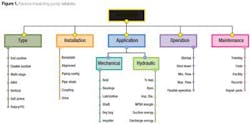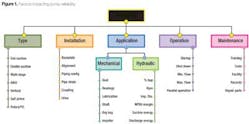By Allan R. Budris
There are many elements that must come together to insure a reliable mean-time-between-failure (MTBF) pump application, as shown in Figure 1. Over the almost six years the writer has been doing this column, most of these topics have been covered at least once. It seems appropriate to elaborate on how these individual pump reliability columns fit together into a centralized pump reliability map/index.
The writer's first Pump Tips and Techniques column (July 2007) spelled out the principles below that typically guide best-of-class pump users to use the most reliable pumps.
1. Do not purchase pumps based mainly on the lowest initial cost, but instead consider the total life cycle cost of the pump installation.
2. Evaluate the total pumping system and not just the pump.
3. Make up-front investments in key reliability factors, which include such elements as the pump type, pump driver, installation, lubrication systems, pump speed, pump operating range, suction energy, and training.
4. Do not continue to just repair or replace poor pump performers in kind, but instead determine the root cause of the deficiencies and institute a continuing corrective action program.
As detailed in Figure 1, pump reliability can be broken down into five basic categories: type, installation, application, operation, and maintenance, with application further broken down into mechanical and hydraulic subgroups. In addition, each of these categories covers a handful of issues that must be optimized for maximum pump reliability.
PUMP TYPE: Selecting the right pump type for an application can be critical for pump reliability. There are often multiple pump types that can be selected for the same water/wastewater application, with each pump type having its own strengths and weaknesses.
The writer's Aug. 2011 column spells out guidelines to help readers select the best horizontal pump type that will yield the greatest reliability and lowest life cycle cost for a specific application. The pump types evaluated were the end suction water, end suction stock/process, end suction ANSI B-73 chemical, and double suction axial split case configurations.
Other potential pump types, with their strengths and weaknesses, were covered in separate columns: vertical turbine pumps (Sept. 2008), self-priming pumps (Oct. 2012), and rotary/positive displacement pumps (Dec. 2011). Although multistage pumps (Sept. 2009) are mainly used to improve pump efficiency and/or to achieve high pressures, the right selection can also improve reliability by achieving operation closer to the pump's best efficiency flow rate.
With the various pump configurations available for water services, it is important to fully evaluate the strengths and weaknesses of each when selecting a new pump in order to minimize maintenance and life cycle costs, especially for critical applications.
INSTALLATION: The care taken during the installation of a pump can have a significant impact on the reliability of the pump, from the selection and installation of the base plate (Nov. 2010) to the design and installation of the piping configuration to and from the pump (April 2009, Feb. 2013 and April 2013) to the alignment (Sept. 2010) of the pump and coupling (Sept. 2012) to the driver. In addition to the potential of improving pump efficiency, certain drives, such as variable speed, can also improve the reliability of the pump by operating at slower speeds (March 2008, Aug. 2008, Sept. 2011, and Aug. 2012). Variable speed drives can also increase the likelihood of exciting a pump's natural frequency if the maximum operating speed is above a first critical speed, such as with vertical turbine pumps and some multistage pumps.
APPLICATION: This category can be broken down into two sub-categories: mechanical pump components and hydraulic system/applications imposed conditions.
Mechanical: Many of the pump mechanical factors/components that impact pump reliability are predetermined by the pump model and size, but the pump user can select certain critical factors such as the mechanical seal (May 2010 and July 2011) and bearing lubrication (Feb. 2008 and Aug. 2010), which are under the control of the pump user.
Also, with larger high speed pumps, the user may also have a choice of the bearing type (antifriction ball/roller in Aug. 2010 vs. hydrodynamic/hydrostatic sleeves or magnetic bearings in March 2010). Further, with some pumps, especially ANSI B73 end suction models, there are often several bearing housing designs to choose from (May 2011 and Oct. 2011).
Finally, users normally have the choice of several pump component materials of construction or coatings (May 2008 and April 2012), especially for the impeller. Finally, some manufacturers also offer more than one impeller to accommodate several pump flow rates or a very low NPSHR requirement.
HYDRAULIC: The writer has probably seen more pump field problems caused by hydraulic issues than any of the other categories. For this reason, many of the hydraulic reliability factors were combined in the writer's Feb. 2012 column, which shows how various hydraulic factors can be combined to maximize overall pump reliability.
Those factors include the following: pump speed or RPM (April 2008), percent best efficiency point (% bep), flow rate (Dec. 2007), net positive suction head or NPSH margins (Jan. 2010, April 2011, Jan. 2012, Dec. 2012, and Jan. 2013), suction energy (Oct. 2007 and Dec. 2012), and impeller material (see mechanical above).
The two (normally less critical) pump hydraulic reliability factors not covered in the Feb. 2012 column are the impeller diameter (Oct. 2009) and discharge energy (Sept. 2009 and Feb. 2013).
OPERATION: This reliability category is probably the one the pump operator has the most control over, from startup and shutdown to minimum flow (June 2010, March 2011 and May 2013), maximum flow, and pump parallel operation (Nov. 2008 and March 2011). Of these five reliability factors, operation below the pump minimum allowable flow probably has the greatest potential to damage the pump. Maximum flow becomes more of an issue when the NPSH margins drop too low, and/or the higher bearing loads and shaft deflections shorten the bearing and seal life.
MAINTENANCE: Typically, best-of-class pump users have quality maintenance programs which include, as a minimum, training of maintenance personnel and periodic recorded bearing lubrication and vibration monitoring (June 2008 and June 2012), as well as the MTBF of all pumps. Reliability improvement tools (Dec. 2008, May 2009, Dec. 2009, and April 2010) should be employed to maximize the MTBF including pump life cycle cost evaluations. It is also important to make certain that OEM repair parts (Feb. 2010) are used for critical pump replacement parts. Slight dimensional and/or material changes in certain parts such as the impeller can have a large impact on the pump's performance and/or reliability.
Conclusion
Predicting the reliability of a pump is a complex issue. However, in the final analysis, there is nothing better than actual experience with an actual pump in an actual application operating under specific conditions. Finally, it is understood that many of these pump reliability improvement actions could be at the expense of increased initial costs. So the final purchase and operation decisions/actions should look at how these reliability improvements will impact the total pump life cycle costs since reductions in the cost of maintenance and down time and possible improvements in pump efficiency could far exceed any increase in the initiating pump costs. If the MTBF becomes high enough, users could reduce the total initial cost by eliminating the requirement for back pumps as some best-of-class European pump users do today.
About the Author: Allan R. Budris, P.E., is an independent consulting engineer who specializes in training, failure analysis, troubleshooting, reliability, efficiency audits and litigation support on pumps and pumping systems. With offices in Washington, NJ, he can be contacted via email at [email protected].
More WaterWorld Current Issue Articles
More WaterWorld Archives Issue Articles




